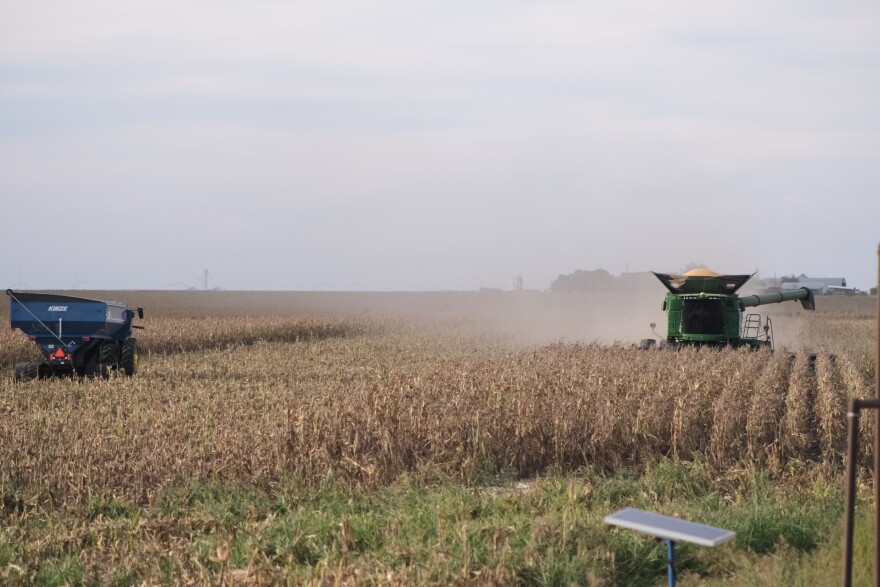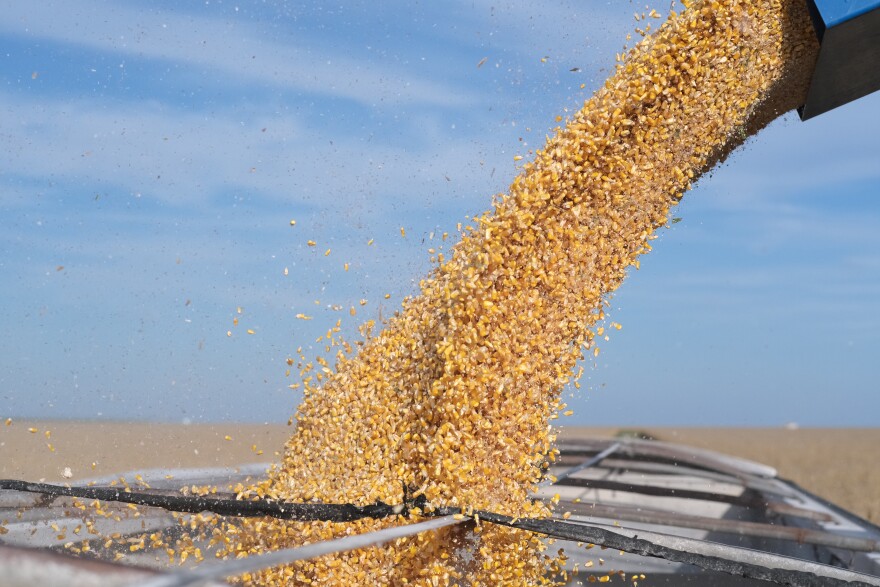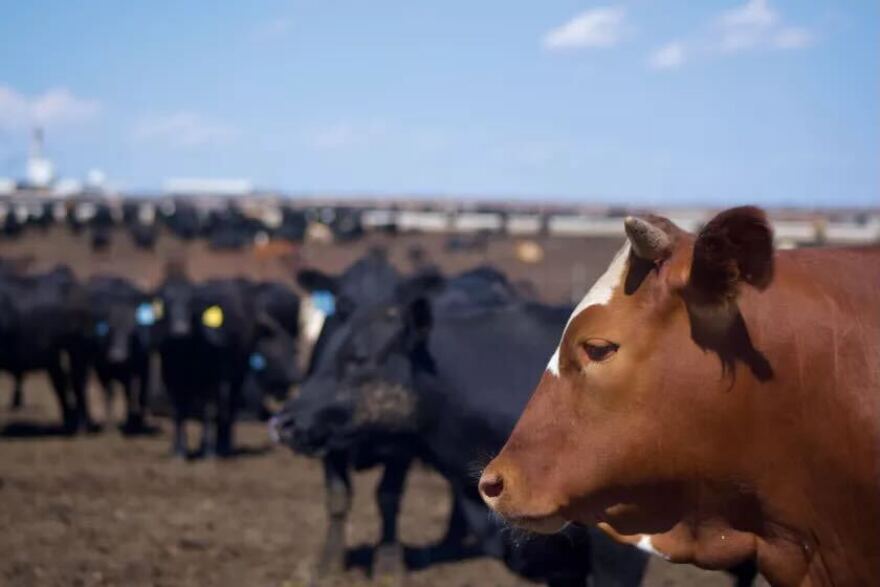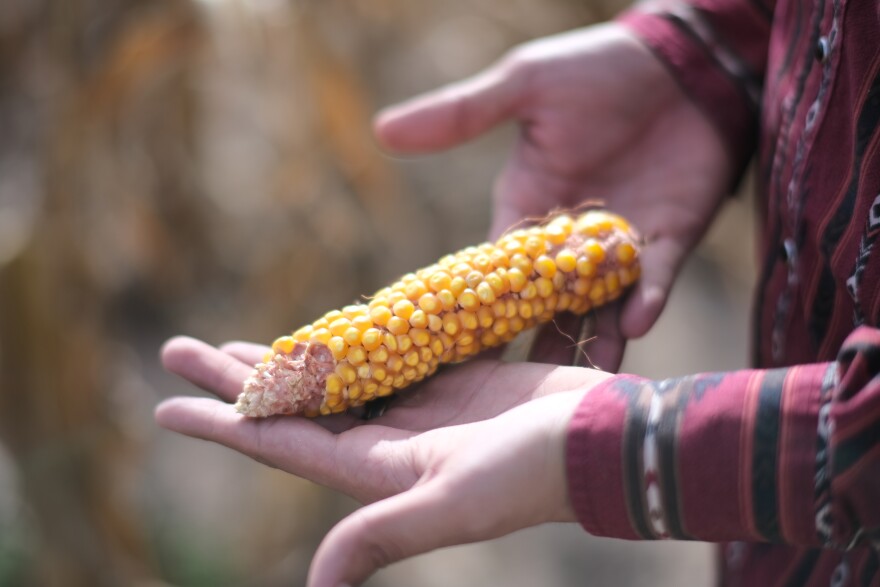It’s harvest time in Kansas. Across the state, combines have begun shaving down and chopping up over 6 million acres of corn.
Isaac Yara is a truck driver, so he sees almost nothing but those corn fields hauling grain across the high plains. This season is a busy one for him.
“I would say the main thing that I haul the most would be corn,” Yara said as he parked his semi for the day.
Why are those signature corn fields so ubiquitous in rural America, including western Kansas where the crop relies on the shrinking Ogallala Aquifer to thrive?
That’s because in western Kansas, there is a huge demand for it. The major corn industry is connected to most of the jobs, like truck driving, the cattle industry and farming.
But the problem is, corn is not as well suited as other crops to this region. All of the economic infrastructure and pressure makes growing corn a simple choice for now, but in the long term it might not be a sustainable option.

The corn you see is generally not for human consumption. A lot of states, including Kansas, plant a shorter, starchier version called field corn.
This corn won’t taste good to us, but it’s perfect for cattle. It’s also good for producing biofuel in ethanol plants. But that main use is pressing that starchy corn into a softer, highly digestible, high-protein feed.
It starts out on the farm. Yara drives his truck out to a farmer’s field, gets loaded up with corn and takes it to feedlots. But not usually the feedlots across western Kansas.
“I'll go pick up in Greensburg, Kansas, or around those areas,” Yara said. “I'll pick up corn there and then I'll just bring it down over to the Texas Panhandle.”
Yara described what the industry refers to as the southward flow of grain across the Plains. Despite Kansas being covered in millions of acres of corn, truck drivers and cattle feedlots will tell you a lot used here still comes from the original corn belt in Nebraska, Iowa or Illinois, not down the road.

“We take fertilizer up north to Nebraska or South Dakota, and we'll bring back corn product, or corn itself,” Yara said.
Grain marketing economist Mark Welch at Texas A&M University said corn is the staple crop for the beef industry. It’s virtually always in demand, it’s also reliable, so a lot of farmers will plant some corn for a steady crop and good returns.
“In terms of dollars per acre, the return possibilities for corn are pretty attractive,” Welch said.
Over the years, hybrids have capitalized on irrigation to survive drier periods, and subsidies from the federal government have made corn common.
Since 1995, the federal government has paid out $21 billion in subsidies for corn to farmers nationwide, making it the most subsidized crop. Second place is wheat with about half of those subsidies.
Kansas corn planting has grown by an average of 50,000 hectares a year since the 1880s. But despite this increase, Kansas still rails in literal tons of corn from the original corn belt.
Welch said part of the reason is the current transport system has been fine tuned. The rails, grain elevators and systems are already in place. It can sometimes be cheaper for a feedlot or dairy to rail in corn from the northeast where high yields contribute to lower prices.

The other reason is cattle are fed a ration that is almost 80% corn, and the rest is a filler often including silage, a fermented grain. A lot of local Kansas corn is turned into silage.
“You're not going to rail that in from Nebraska. It's too bulky. It's hard to maintain condition,” Welch said.
With silage, the entire corn plant is copped up.. Agronomists say silage is best suited for irrigated corn, as it needs to be wet. But shipping all that wet material wouldn’t make sense, financially. So it’s often made locally.
There are other crops that are more water efficient and can be used for silage, like sorghum. But in an industry this massive, the momentum corn already has, makes it hard to change to something else, even with the downsides of corn.
“The seed cost is higher. The fertilizer requirements are higher. If you're going to irrigate it, you might spend more water on corn than you would grain sorghum,” Welch said.

And despite those costs, the demand means corn acres can generate more revenue for farmers compared to sorghum.
Brandon Depenbusch is the vice president of the cattle division at prominent cattle feeding company Irsik and Doll. He said some feedlots in the region have more than 35,000 cattle to feed, and each animal eats up to 30 pounds of corn a day.
Western Kansas is also home to mega feedlots, feeding up to 80,000 cattle a day. Even with the increase in Kansas corn acreage, it’s not enough.
“I would explain some of our feed yards as a city,” Depenbusch said. “We run a city, and the citizens are cattle. They got to have groceries to eat.”
Corn is a crop that yields much higher with irrigation. When irrigated, corn can yield almost 300 bushels an acre in Kansas. Without irrigation, it might be half of that in a good year. Corn is the most commonly irrigated crop in Kansas. More than a third of the 3 million irrigated acres in Kansas produce corn.
Kansas farmers have access to irrigation through the Ogallala Aquifer. But that access has been in danger after years of pumping for crops has resulted in the aquifer running almost dry in some places.
Given the water usage and the climate challenges in Kansas for the crop, farmers and industry leaders have had to take a hard look at whether corn is still worth it.

Depenbusch said that he believes in the beef industry and its ability to adapt. Maybe feedlots in the future will be able to transition to another high protein feed that can grow with less water nearby, like sorghum.
But feedlots and ethanol plants are set up to process corn kernels. A sorghum berry is smaller, and could take twice as long to process for a feedlot.
That’s just another example of how fine tuned things are for corn, making it harder to switch crops. But that doesn’t stop Depenbusch’s optimism.
“It's just going to look different. But by God, it needs to look different. If we're doing the same thing 20 years from now that we are today, that's a dying industry,” Depenbusch said.
“We have to evolve, and we will,” he said.
Calen Moore covers western Kansas for High Plains Public Radio and the Kansas News Service. You can email him at cmoore@hppr.org.
The Kansas News Service is a collaboration of KCUR, Kansas Public Radio, KMUW and High Plains Public Radio focused on health, the social determinants of health and their connection to public policy.


